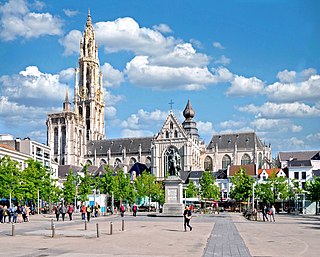
The Cathedral of Our Lady is a Roman Catholic cathedral in Antwerp, Belgium. Today's seat of the Diocese of Antwerp started in 1352 and, although the first stage of construction was ended in 1521, has never been 'completed'. It was constructed in the Gothic style by architects Jan and Pieter Appelmans. It contains a number of significant works by the Baroque painter Peter Paul Rubens, as well as paintings by artists such as Otto van Veen, Jacob de Backer and Marten de Vos. The cathedral is the largest Gothic church in Belgium, with its tower rising 123 meters over the city.

The Church of Our Lady is a Roman Catholic church in Bruges, Belgium, dating mainly from the 13th, 14th and 15th centuries. Its 115.6-metre-high (379 ft) tower remains the tallest structure in the city and the third tallest brickwork tower in the world.

Jakarta Cathedral is a Roman Catholic cathedral in Jakarta, Indonesia, which is also the seat of the Roman Catholic archbishop of Jakarta, currently Archbishop Ignatius Suharyo Hardjoatmodjo. Its official name is Gereja Santa Maria Diangkat ke Surga, derived from the original name in Dutch, De Kerk van Onze Lieve Vrouwe ten Hemelopneming. This current cathedral was consecrated in 1901 and built in the neo-Gothic style, a common architectural style to build churches at that time. The Jakarta Cathedral is located in Central Jakarta near Merdeka Square and Merdeka Palace, right in-front of the cathedral stands the Istiqlal Mosque.
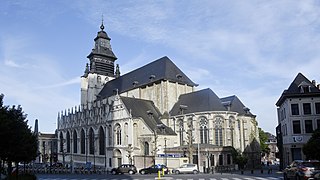
The Church of Our Lady of the Chapel, or the Chapel Church, is a Catholic church located in the Marolles/Marollen district, in the historic centre of Brussels, Belgium. It is dedicated to Our Lady of the Chapel.

Melsele is a town in the Belgian province of East Flanders, between the city of Beveren and the nearby town of Zwijndrecht. Tram route 3 which starts just outside the town connects it to Zwijndrecht and Antwerp. The town's road links include the E17 and the E34.

The Church of Our Lady of Laeken is a Catholic parish church in the Brussels district of Laeken, Belgium. Built in neo-Gothic style, it was originally erected in memoriam of Queen Louise-Marie, wife of King Leopold I, to the design of the architect Joseph Poelaert.
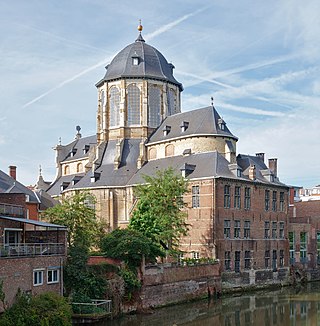
The Basilica of Our Lady of Hanswijk is a Roman Catholic basilica in Mechelen, Belgium. The basilica is a famous place of pilgrimage in Belgium, the statue was crowned on 30 July 1876 by Cardinal Deschamps by request of pope Pius IX.
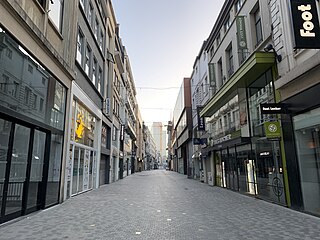
The Rue Neuve or Nieuwstraat (Dutch), meaning "New Street", is a pedestrian street in central Brussels, Belgium. It runs between the Place de la Monnaie/Muntplein and the Rue du Fossé aux Loups/Wolvengracht to the south and the Place Charles Rogier/Karel Rogierplein and the Boulevard du Jardin botanique/Kruidtuinlaan to the north.
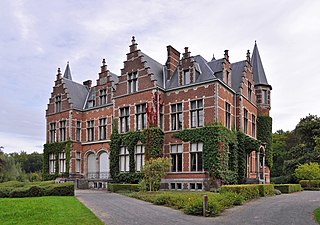
Oelegem is a village and deelgemeente (sub-municipality) of the municipality of Ranst in the province of Antwerp, Belgium. The village is located about 14 kilometres (8.7 mi) east of the city of Antwerp.
Onze-Lieve-Vrouwekerk is a common church dedication in Belgium and the Netherlands and may refer to:

The Church of Our Lady of Leliendaal is a Roman Catholic church in Mechelen, Belgium, served by the Society of Jesus. It was designed by Lucas Faydherbe and is a protected structure, designated by the city council of Mechelen as one of its eight historic churches.

The Church of Our Lady of Victories at the Sablon, or the Church of Our Lady of the Sablon, is a Catholic church located in the Sablon/Zavel district, in the historic centre of Brussels, Belgium. It is dedicated to Our Lady of the Sablon.

Jan Swerts was a Belgian painter of historical subjects and portraits who worked on many publicly funded commissions. He played a major role in introducing German Romantic historical painting into Belgium. His fresco's using oil paint heralded a revival of a colouristic style derived from Rubens and Flemish Baroque painting combined with historical and psychological realism.
The Abbey of Onze-Lieve-Vrouw ter Nieuwe Plant, formerly also Roesbrugge Abbey is a community of Augustinian canonesses belonging to the Congregation of Windesheim. The sisters are informally known as the Roesbrugge Dames - the Roesbrugge Ladies. Located in Roesbrugge from 1239 to the late 16th century, the community then moved into Ypres, West Flanders, Belgium, where it exists today. Its adjacent school is the Lyceum Onze Lieve Vrouw ter Nieuwe Plant.
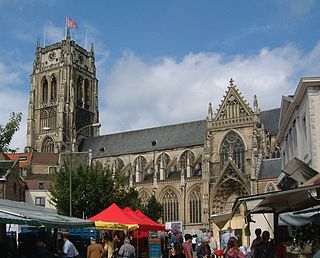
The Basilica of Our Lady, also called Old Cathedral of Tongeren, is the main place of Catholic worship in Tongeren, Belgium, and the former cathedral of the suppressed diocese of Tongeren.

The church of Our Lady, Melsele is a Roman Catholic parish church in Melsele, in the commune of Beveren, in East Flanders, Belgium. It is a registered heritage site.

Huibrecht, Hubrecht, Hubertus or Hubert van den Eynde was a Flemish sculptor. He is mainly known for his religious sculptures and church furniture although he also worked on some secular projects. He was the first prominent sculptor of the van den Eynde family of artists and merchants. In the early 17th century, van den Eynde was one of the leading Flemish sculptors who rejected contrived Mannerist formulae in favour of greater realism. His work shows a development from the early Baroque to the high Baroque. His late style is characterized by a penchant for movement and dashing draperies.

The Le Grelle family is a family of imperial, Dutch, Papal, and Belgian nobility.




















